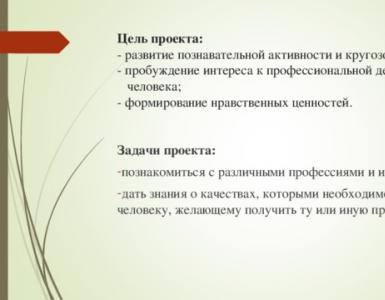Bears sleep for three to five cold months, but not everywhere. Features of animals: why a bear hibernates How a bear hibernates
28.11.2016 15:08
1462
Why do bears hibernate?
You probably know that bears (as well as some other animals) hibernate in winter. Do you know why they do this? The fact is that winter is one of the most difficult periods in the life of animals, and if it also turns out to be harsh, then it’s really bad. At such times, the instinct of self-preservation kicks in for many animals and they try to hide in warm places.
Winter hibernation of bears is the most striking example of how animals wait out the cold season; thanks to it, bears have the opportunity to skip all the most severe frosts.
A long winter's sleep is main feature bears and many other animals (badgers, hedgehogs, moles, frogs, etc.), which serves them as protection from long and cold winters. During such hibernation, the animal’s body undergoes a complete restructuring: breathing becomes rare, the heartbeat slows down, and body temperature drops. Scientifically, such a dream is called suspended animation.
Bears hibernate mainly because they do not make any reserves for the winter, as do squirrels and other animals. Despite the fact that bears are predators of impressive size, their main food is summer period are berries, mushrooms and plants that disappear with the onset of cold weather.
In addition, over the summer, bears accumulate a huge layer of subcutaneous fat, which will be enough for them not to want to eat during hibernation. It is the accumulated reserve of fat that allows the bear to forget itself in winter sleep for entire months, without remembering the severe frosts and winter hunger.
Of course, there is a possibility that there will be berries or other fruits under the snow, but they will not be able to satisfy the hunger of an animal whose weight can reach 500 kilograms.
It is curious that some species of bears before " winter holidays“They take care of the structure of their den. For example, a brown bear arranges its winter home with branches and twigs.
One more interesting fact is that bears suck their paws during winter sleep. There are several options to explain this behavior of clubfoot predators.
According to the first version, the animal thus helps the molting process by biting off old areas of skin on the paw. The fact is that on the feet of bears there is a rather thick layer of skin, which helps these animals move on rough and uneven surfaces. During winter sleep, this layer begins to renew itself, i.e. The old skin peels off, and a new one grows. To ensure renewal on the soles of the paws occurs as quickly as possible, bears suck on them.
The second explanation for why a bear sucks its paw is that in this way it eats up the remains of plant food on its paw. The fact is that during the summer, a huge number of different berries, fruits, leaves, and insects stick to the feet of this predator. Over time, they trample, dry out and turn into a kind of “packed ration”, which serves as a supplement to winter sleep. This allows the clubfoot to dream and gradually suck food.

If we talk about hibernation, during this process all vital signs are practically reduced to zero. The animal's body temperature drops and becomes only slightly higher than the air around it. This is what allows you to reduce energy consumption. If external factors environment change, for example, if the temperature in the den drops, the animal wakes up, insulates itself (by burying itself in snow or bedding) and goes back to sleep. Thanks to this, it is possible to retain more heat, therefore, there will be less energy consumption, and the bear will safely survive to get out into the forest again in the summer.

Features of hibernation
It is known that not all bears hibernate. Polars differ from their European relatives. While the rest are quietly snoring in their dens, they are actively looking for food. The exception to the rule is pregnant females, who hibernate for several months until they give birth to their babies. After the birth of the cubs, the she-bear leaves the den and continues active life in search of food.
It is better to never wake up a bear sleeping in a den, since the clubfoot wakes up in one moment, and at the same time it becomes 100 times more dangerous. Such cases are extremely rare for a person to stumble upon a den in winter. Bears choose very secluded places in the forest, where perhaps no human has even set foot.
Scientists have been trying to unravel the mystery of the forest giant for years. After all, it has not yet been precisely revealed what allows them to remain in complete hibernation for up to 7 months. By answering this question, scientists hope to make substances used by animals for humans as well. This, in turn, will help a person safely fall into a long sleep without harm to the body. One way or another, all these are just developments, but for now people can only envy the bear’s heroic sleep.
In the life of any animal, severe winter is a very difficult period. At this time, animals try to hide in a warm place - the instinct of self-preservation pushes them to do this. One of the most striking examples of how animals spend the winter is the hibernation of brown bears, which allows them to cope with frost and bad weather.
Winter characteristics of the animal body
A key feature of the body of many living creatures is the need for winter sleep. Not only bears, but also other animals hibernate:
- badgers;
- frogs;
- moles;
- reptiles.
Sleep is a kind of protection from the cold and long winter. During winter sleep, the animal's body is rebuilt. Breathing and heart rate slow down, body temperature drops - the animal falls into a state of suspended animation.

Why does a bear need sleep?
If we are talking about bears, then they fall asleep for the reason that they do not make any reserves, unlike squirrels, hamsters, and other animals. A bear is a large animal, but it usually feeds on berries, mushrooms, and plants. And all this disappears with the onset of winter.
We also note that during the summer the bear accumulates subcutaneous fat. This layer is enough for him so as not to go hungry during sleep. Thanks to the accumulated reserve of fat, the animal falls into a long sleep and is not bothered by severe frosts. There are some types of bears that set up their den in anticipation of hibernation. For example, brown bears use various twigs and twigs for this.

We must add to this that the bear needs winter sleep not only to fight hunger. For example, a pregnant female polar bear also hibernates. Despite the fact that this process can occur at any time of the year, in most cases it happens in winter time. Polar bears do not tend to make dens; they only make snow holes. The bear sucks its paw, helping the molting process. But there is another version, according to which the animal eats small pieces of food that remain on its paw.
Updated: 12/27/2017It’s good for those who have wings - they flew away and that’s it. well and brown bear through the thickets and wild forest can’t get to places where the climate is warmer.
And he finds a rather practical solution. In the summer, the bear eats its food and then goes into hibernation until spring. But not everything is as simple as it might seem at first glance. Imagine what you would be like if you didn’t drink or eat for six months. Let's get acquainted with some amazing processes that occur in the body of a bear during hibernation.
Busy summer
To prepare for the six-month “fast,” the she-bear needs to make energy reserves.” So she doesn't worry about her figure. Its main goal is to accumulate more subcutaneous fat (in some places its thickness reaches eight centimeters). Although she likes sweet berries best, she is not picky about food. She eats everything: roots, small mammals, fish and ants. By autumn, she can gain weight up to 130-160 kilograms, a third of which is fat. (The male can weigh up to 300 kilograms.) Before plunging into the world of dreams, she stops eating and emptys her intestines. For the next six months she does not eat anything, does not urinate or defecate.
Bears choose a place for a den in a cave, an abandoned anthill or a depression under the roots of trees. The main thing is that it is quiet there and no one disturbs your sweet sleep. Bears collect spruce branches, moss, peat and other materials to make a warm and cozy bed. The den is not much larger than the massive body of the bear. When winter comes, snow will cover the den and only an attentive observer will be able to see the hole through which air enters there.
Hibernation
Some small mammals, such as hedgehogs, the bats and sleepyheads fall into the present hibernation, that is, they spend most of the winter in a state similar to death. Their body temperature approaches the ambient temperature. But a bear's body temperature only drops by 5 degrees Celsius, so its sleep is not that deep. “You can’t say that a bear ‘sleeps without its hind legs.’ The bear raises its head and turns from side to side almost every day,” says Raimo Hissa, a professor at the University of Oulu in Finland, who has spent many years studying bear hibernation. Yet the bear rarely comes out. from her den in the middle of winter. During hibernation, the animal’s body works “in economy mode.” The heart rate drops to 10 per minute, and the metabolic process slows down. When the bear sleeps sweetly, fats begin to be burned in her body. Fatty tissues are broken down by enzymes and supply the animal's body with the necessary calories and water. Although the processes that support life in the body slow down, a certain amount of waste is generated as a result of metabolism. How can a mother bear get rid of it and at the same time keep her den clean? Instead of removing waste , the body processes them!
Professor Hissa explains: “Urea from the kidneys and Bladder reabsorbed into the blood and transported circulatory system into the intestines, where it is hydrolyzed by bacteria into ammonia.” Even more surprising is that this ammonia goes back to the liver, where it participates in the formation of new amino acids that form the basis of proteins. By converting waste into building materials, the bear's body feeds itself during a long period of hibernation!
In the old days, people hunted bears sleeping in dens. Sleepy Toptygin became easy prey. First, hunters on skis found a den, then surrounded it. After this, the bear was woken up and killed. Today, winter bear hunting is considered a cruel activity, and it is banned almost throughout Europe.
Studying bear hibernation
At the Department of Zoology of the University of Oulu, research has been carried out for several years on the physiological processes by which animals adapt to cold. Brown bears began research in 1988, and in total over the years, observations were carried out on 20 individuals. A special den was created for them in the zoological garden of the university. To measure body temperature, study metabolism, vital activity, as well as changes that occur during hibernation in the blood and hormones, scientists used computers, video cameras, and did laboratory tests. Biologists collaborated with specialists from other universities, even Japanese ones. They hope that the research results will be useful for solving problems related to human psychology.
New life
The bear sleeps all winter, turning from side to side, but an important event occurs in the life of the bear. Bears mate in early summer, but the fertilized cells inside the expectant mother's body do not develop until the mother hibernates. The embryos then attach to the wall of the uterus and begin to grow. After just two months (in December or January), the body temperature is expectant mother rises a little, and she gives birth to two or three cubs. After this, her body temperature drops again, although it does not become as low as before childbirth. Papa Bear does not see his children being born. But the sight of newborns would probably disappoint him. It would be difficult for a huge dad to recognize these tiny creatures weighing less than 350 grams as his offspring.
The she-bear feeds the cubs with nutritious milk, this depletes her already weakened vitality. The cubs grow quickly, by spring they become fluffy and already weigh about five kilograms. This means that the bear’s small “apartment” is full of excitement.
Spring
March. Cold winter has passed, the snow is melting, the birds are returning from the south. At the end of the month, male bears emerge from their dens. But the mother bears remain in their shelter for several more weeks, perhaps because the babies take a lot of their energy.
After a long hibernation, all that remains of a well-fed bear is skin and bones. The snow melted, and with it her fat melted. With all this, the bear is surprisingly mobile - no bedsores, seizures or osteoporosis. Some time after leaving the den, she cleanses the intestines. Typically, bears begin to eat only two or three weeks after waking up, since the body does not immediately get used to the new conditions. But then they develop a remarkable appetite. But since nature itself has recently awakened from winter sleep, at first there is not much food in the forest. Bears chew larvae and beetles, eat old carcasses, and sometimes even hunt reindeer.
The care of raising cubs falls on the shoulders of the mother bear, and she protects her cubs like the apple of her eye. An ancient proverb says: “It is better for a man to meet a mother bear without children than a fool with his foolishness” (Proverbs 17:12). In other words, it is better not to date either one or the other. “Mama bear has a lot on her plate. If a male bear approaches, she immediately forces the cubs to climb a tree. The point is that the male can harm them, even if he is their father,” explains Hissa.
The cubs spend another winter in the den with their mother. Well, next year they have to look for their own den, since the bear will have new tiny cubs.
We already know a lot about the complex and unusual phenomenon of bear hibernation, but much still remains a mystery. For example, why does a bear become sleepy in the fall and why does it lose its appetite? Why doesn't he have osteoporosis? Uncovering a bear's secrets is not easy, and that's understandable. Everyone has their own secrets!
Instructions
Winter sleep is the main feature of bears and many other animals (badgers, hedgehogs, moles, frogs, reptiles, etc.), which is a kind of measure of their protection from long and cold winters. During winter sleep, the animal's body begins its complete restructuring: breathing becomes rare, the heartbeat slows down, and the body temperature drops. Animals fall into suspended animation.
If we talk about bears, they fall into this state because they do not bother to make any supplies for the winter in a timely manner, as do squirrels, hamsters and other animals. Despite the fact that bears are predators of impressive size, their main food in the summer is berries, mushrooms, and plants, which disappear with the onset of cold weather.
In addition, over the summer, bears eat enough and accumulate a huge layer of subcutaneous fat, which will be enough for them not to want to eat during hibernation. It is the accumulated reserve of fat that allows the bear to forget itself in winter sleep for entire months, without remembering the severe frosts and winter hunger. Of course, there is a possibility that there will be berries or other fruits under the snow, but they will not be able to satisfy the hunger of an animal whose weight can reach half a ton. It is curious that some species of bears take care of setting up their den before their “winter rest.” So, they equip their winter home with branches and twigs.
It is worth noting that not all bears go into winter sleep only to survive hunger. For example, female polar bears fall into, being. It is curious that this process in polar bears can occur at any time of the year, but most often it happens. Polar bears do not build their dens, they simply dig large holes.
It is also interesting that bears suck their paws during winter sleep. There are several versions explaining this behavior of clubfoot predators. According to the first version, the animal helps the molting process by biting off old areas of skin on the paw. The fact is that on the feet of bears there is a rather thick layer of skin, which helps these animals move faster on rough and uneven surfaces, and the bears suck on them.
The second version says that the bear eats the remains of plant food on its paw in this way. The fact is that during the summer, a huge number of different berries, fruits, leaves, and insects stick to the feet of this predator. Over time, they trample, dry out and turn into a kind of “packed ration”, which serves as a supplement to winter sleep. This allows the clubfoot to dream and suck berries.













